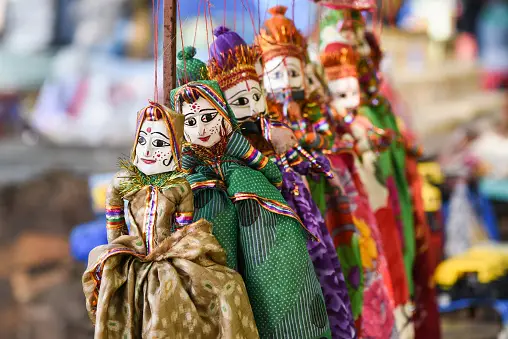Folk art captures the essence of a community and is a colorful tapestry of cultural expression. Its stories, beliefs, and aesthetic tastes are distilled from a variety of cultures and are rooted in traditions. Indian folk art is a remarkable representation of the nation’s rich legacy due to its kaleidoscopic diversity.
The Indian Folk Art Mosaic
Taking Off on a Colorful Adventure
The folk art of India is a celebration of diversity, with distinct regional styles. There are many different artistic interpretations on the Indian canvas, ranging from the Warli art of Maharashtra to the Madhubani paintings of Bihar. Folk artists, who are frequently from rural areas, tell stories about mythology, the natural world, and everyday life using vivid colors and straightforward shapes.
To give their creations life, artists in the realm of folk art painting employ strong brushstrokes and vibrant colors. Transmitting stories that have been handed down through the generations, the canvas takes on the role of a storytelling medium. Each color stroke adds to the overall visual symphony in this color dance.
The allure of folk art drawings
Simplicity is paramount in the realm of folk art drawing. Artists use simple shapes and lines to establish a fundamental connection with the audience. The simplicity of beauty that arises from these seemingly simple strokes is what makes them charming. It’s a kind of art that unites people by bridging language divides to convey feelings that are shared by everyone.
Exploring the Field of Folk Art
Dissecting the Tradition’s Threads
Folk art connects threads of tradition and is a cultural document as much as a work of aesthetic beauty. These art forms are essential to the identity of the community since they frequently have their roots in customs, rites, and everyday life. The artists, who are frequently self-taught, continue ancient techniques, ensuring the continuity of a lineage.
Simple Folk Art Painting’s Allure
The allure of simple folk art painting has recently captured the attention of art fans all around the world. Because of the technique’s simplicity, even people with little artistic experience can master it. Easy folk art painting is like taking part in a cultural conversation where you use the common language of art to communicate stories.
The Continuity of Folk Art Traditions
Silent Voices Resonating Across Time
Techniques are frequently handed down from generation to generation in the world of Indian folk art. The narratives conveyed by the brushstrokes are more than just stories; they are actual experiences that reverberate beyond time. Methods are maintained, and every blow is infused with the knowledge of the past.
Making the present
The charm of folk art, however, is found in its active engagement with the present as well as its historical resonance. While remaining faithful to the essence of the folk art genre, contemporary folk artists enrich their creations with fresh stories. It is a celebration of continuity and growth, a lively conversation between the past and present.
Preserving Traditions via Folk Art
Preserving Measures
Various initiatives have evolved to help folk artists in recognition of the significance of preserving this cultural heritage. Governmental agencies, cultural groups, and NGOs work together to offer venues, training sessions, and funding. In addition to preserving the livelihoods of folk artists, these initiatives seek to maintain the vitality of these artistic traditions.
The appreciation of folk art transcends national borders. Scholars, collectors, and art aficionados actively work to comprehend and preserve these distinctive manifestations. As a means of linking traditional artists with a global audience, auctions and exhibitions of Indian folk art have gained popularity.
Indian Traditional Art in the World
Worldwide Acknowledgment
Indian folk art has become recognized on a worldwide scale in the era of globalization. Audiences all across the world respond to its distinct aesthetic, which is firmly rooted in cultural narratives. A discerning and appreciative public can see Indian folk art in galleries in significant international cities.
International Art Discussions
The increasing global reputation of Indian folk art causes it to quietly become part of larger discussions about art and culture. Passive integration, which does not stifle its individuality but instead blends harmoniously, improves the global artistic discourse. Folk artists from India tell stories that resonate deeply with people, even outside of their country of origin.
Using Folk Art as a Healing Medium
Utilizing Creativity for Healing
In addition to its cultural value, folk art provides therapeutic benefits. Participating in folk art creation provides a contemplative haven for people. The vivid hues and rhythmic brushstrokes serve as a therapeutic and consoling medium for self-expression. Engaging actively in the artistic process turns into a way to let go of emotions.
Beyond the artist, folk art has therapeutic benefits. A passive but strong therapeutic effect is felt by those who interact with these creations, whether they are observing or making them. Folk art offers a break from the complexity of contemporary life due to its genuineness and simplicity, which appeal to the human soul.
The Active Evolution of Folk Art in the Future
Accepting Innovation
The folk art of the future is dynamically evolving rather than static. It’s an active reaction to the dynamic world, ensuring that these classic statements remain relevant.
However, the passive legacy is still present despite this active progress. The tales, methods, and cultural quirks passed down through the generations form an unbroken link connecting the past and the future. The essence of folk art is continuity; it is a living legacy that changes without losing its essential characteristics.
In summary, folk art is a colorful tapestry woven with threads of invention and tradition, particularly Indian folk art. This ongoing tradition is preserved thanks to artists’ active participation in creating, expanding, and sharing their cultural heritage.


